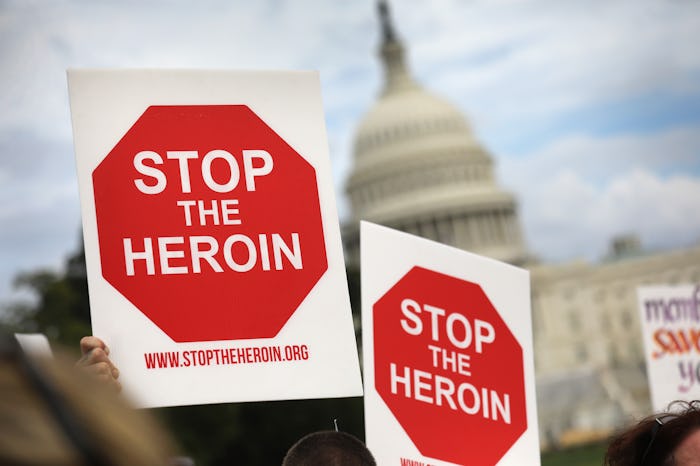News

Are The Majority Of Drugs Coming From Mexico?
On Monday, the Associated Press released its transcript of its interview with President Donald Trump, who spoke about his first 100 days in office. Trump again spoke of his infamous wall, and how it will become a working monument to America's war on drugs. "The wall will stop the drugs," Trump told the AP's White House correspondent Julie Pace on Friday, after noting that "drugs are pouring through on the southern border." Are the majority of drugs coming from Mexico into the United States?
According to the U.S. Drug Enforcement Administration, much of the nation's most used illicit drugs are actually coming from Mexico and other South American countries — but the drug crisis in American is far more complicated than just illicit border crossings and drug mules. While America's opioid epidemic touches every corner of the country, it didn't start at the U.S.-Mexico border — rather, it began in doctors' offices and hospitals.
Abuse of prescription painkillers like OxyContin has often become a gateway to heroin. When the prescription runs out but the addiction remains, heroin is an alternative to circumvent increasing — and necessary — regulatory restrictions on prescription painkillers. Even though the drugs may be getting into the United States through its southern border, the problem starts long before Mexican drug cartels ever come into the picture.
Between 2007 and 2013, the United States saw a 244 percent jump in heroin-related deaths, according to the Centers for Disease Control and Prevention. A February report from the CDC revealed that 25 percent of overdoses are from heroin. Nearly all of America's heroin comes from Mexico and South America, according to the DEA. While heroin production is typically associated with the poppy fields of Afghanistan, the reality in 2017 is that 46 percent of America's heroin now comes from Mexico, thanks in large part to Mexican drug cartels.
Likewise, most of America's fentanyl comes from Mexico, according to the DEA. Fentanyl is a controlled pharmaceutical painkiller much like morphine, oxycodone, or hydrocodone — but is far more potent. In 2016, musician Prince accidentally overdosed on fentanyl; this type of death is not uncommon among people who abuse painkillers as they fail to realize just how potent and deadly fentanyl can be in small doses. Increasingly, law enforcement have found that batches of heroin have fentanyl "cut in" to the final product, creating regional spurts of fentanyl-laced heroin overdoses and deaths.
In addition to heroin and fentanyl, much of America's methamphetamine, known as "meth" and "crystal meth," also comes from Mexico — and not just from chemistry teachers's vans in the New Mexico desert, as Breaking Bad would have you believe. But America's meth labs — particularly in the Midwest — are certainly a homegrown problem as pervasive as illegally trafficked Mexican meth is invasive.
While there's no doubt that the majority of America's most illicit drugs come from Mexico, building a wall will do little to stop drugs from "pouring through" the nation's Mexican border. Trump's argument is that a physical wall will somehow halt the entirety of the illegal Mexican-U.S. drug trade. While drug seizures at the U.S.-Mexico border are common, just how drugs come into the United States isn't just limited to land crossings. As the DEA noted in its 2015 National Drug Threat Assessment Summary, drug smugglers are even using drones to send drugs into the country.
The wall could stop some of the drug traffic into the United States, but it certainly won't stop all of it. Trump himself even noted that his wall might only stop as little as "1 percent of the drugs coming in," as he told the AP Friday. Trump thinks his wall will only cost $10 billion, but a U.S. Department of Homeland Security internal report obtained by Reuters estimates Trump's wall will cost more than $20 billion — and that's an awful lot of money for a what amounts to a wide-mesh drug sieve rather than an airtight wall against drugs from Mexico.
As much as Trump wants to put "America first," he could learn a thing or two from Portugal and Uruguay. Portugal was the first European country to decriminalize drugs. Instead of seeing addicts as criminals, Portugal takes a rehabilitative approach. Uruguay legalized marijuana in 2013, taking the cue from other nations who focus on rehabilitation instead of criminalization. In both countries, the results have been astonishing: Portugal has the lowest drug use rates in Europe. Uruguay has managed to substantially undermine marijuana trafficking by allowing its government to sell a gram of marijuana for just $1; consumers are limited to 40 grams per month.
It's important to remember that decriminalization doesn't mean you can pick up your dime bag of weed at your local grocer's — but it's the first step to changing the "culture of drugs" Trump repeatedly brings up when he justifies his wall. If America starts treating drug addiction as an illness instead of a crime, then there's no need to build a wall. America's war on drugs has failed. It's time to stop investing in war and scare tactics and direct that money towards rehabilitation.
But Trump has already proven he won't be the leader to take on that helm, when he advocated for a Republican health care bill that would have eliminated addiction treatment as an essential health benefit. For Trump, it's all about making grand gestures in black and white — from his show-and-tell executive order signings to building a wall — but tackling America's drug problem requires far more nuanced finesse than this administration has been able to demonstrate in its first 100 days.